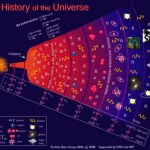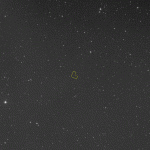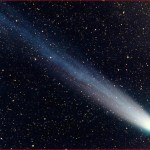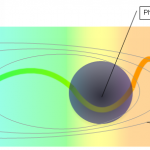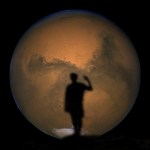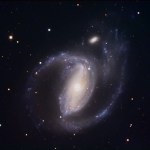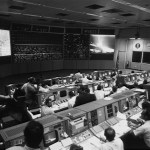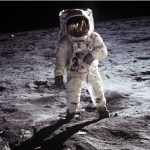Astronomy
This week's Carnival of Space introduced me to a new site, Habitation Intention. As always, the collection of space-related stories from around the 'net is worth checking out, and I've got my top three picks for you.
1. Goodbye, Moon and Mars! What, you thought that my opinion was shared by many? That we'd find a way to resume manned spaceflight to other worlds? That's we'd head to Mars after maybe stopping off at the Moon first? It isn't going to happen, says Cumbrian Sky. They've got the heartbreaking tale of death due to lack of funding, with some nice anger to go along with it.
2.…
About four months ago, the Mars Rover Opportunity was driving around Mars at about 50% power, as five years of accumulated Martian dust on its solar panels was disastrously affecting its ability to acquire power:
But a fortuitous, powerful gust of wind knocked much of the dust off, boosting Opportunity's power by about 40%. Because of this, Opportunity was able to continue making its way towards Endeavor crater -- the largest Martian crater that will ever be examined by any rover -- with an added power boost:
Well, a few weeks ago, Opportunity was cruising along the Meridiani Planum when it…
So, the Universe started with a bang. Everything was hot, dense, and expanding.
It's 13.7 billion years later now, and our Universe is cold and sparse. The temperature of the leftover glow from the big bang -- which used to be over 10^30 degrees -- is now down to 2.7 Kelvin, just barely above absolute zero. The Universe used to be denser than the center of the Sun. Now, on average, the density of the Universe is only about one proton per cubic meter, with mass clumped into stars and galaxies separated by trillions of miles.
But, for all of it, the Universe is still expanding. What's amazing…
It wasn't all that long ago that I wrote a five-part series on Hubble's old camera, WFPC2. I call it "The Camera that Changed the Universe." Part 1 focused on Hubble showing us just how deep, rich, and full of wonder our Universe is. Let's remember how this happened.
The first thing we did was take a patch of sky that was relatively empty. No bright stars, no large galaxies or clusters, no planetary nebulae, just a little tiny patch of black, empty sky.
And then we point Hubble at it. And what do we do? We sit there. And wait. Collecting tiny, miniscule amounts of light. First, for minutes…
When you go outside at night, on a clear night away from all lights, you see the sky the same way the ancients did: full of stars.
Now, if you looked up periodically, you would find that the sky appears to rotate! Some constellations rise while others set, and one point -- either due north or due south depending on your hemisphere -- appears to not move at all. With the advent of time-lapse photography (and go here for a fantastic video), we can see that the sky does something like this:
So there's some pretty good evidence, right away, that either the Earth is rotating or the entire sky is…
This week's Carnival of Space comes from New Frontier News, which has the oddest banner I've seen on a serious science website in a while:
The top three entries this week? As chosen, fairly arbitrarily, by me?
1. Pluto: planet or not? Apparently, the IAU got together again, for the first serious meeting since declassifying Pluto as a planet back in 2006. What happened? They didn't even talk about it. Alan Boyle has the story.
2. Iceteroids! What do you call a half-comet, half-asteroid? Mang at Mang's Bat Page talks about these newly discovered objects, called Main Belt Comets (MBCs).
3.…
There's a good reason for it, I promise! Allow me to explain. You see, every so often, a comet zooms in from the Kuiper Belt. As it approaches the Sun, it heats up, displaying a spectacular tail.
What is this "tail" actually? It's tiny, tiny fragments of ice and rock that make up the comet. You see, comets are like miniature, frozen planets. The gravity holding a comet together is amazingly weak because they're so tiny. For comparison, a grain of sand on the surface of a comet experiences less than 0.002% of gravity on Earth. This gravity is so small that tiny, micron-sized pieces of dust,…
Last week, we began talking about understanding the size of the Universe, and we continued this week with some information on distances and motion in the Universe. This brings us to my favorite application, which leads to the Hubble expansion:
Redshift. You see, whenever an atom or molecule emits light, it gives off that light at a very few particular wavelengths. For instance, if you have hydrogen, you'll always get light at wavelengths of 656 nanometers (red), 486 nm (cyan), 434 nm (indigo), 410 nm (violet), and 397 nm (on the border of violet/ultraviolet):
Now there are three things --…
Those of you who've been reading this site regularly know that we've been very busy of late, finishing our series on the last 100 years, working on raising money for charity, and discussing the deep issues of distances and motion in cosmology. But there is a whole lot of other space news buzzing around the internet, and each week, it gets wrapped up in a giant Carnival of Space.
The 114th edition is up at Cheap Astronomy, and my top three picks this week are as follows:
1.) Why aren't we Going to Mars? Cumbrian Sky takes a good look at Mars, and expressed sadness and frustration at how our…
A wonderful and alert reader writes:
i know you have lots of astronomer readers, so you probably already know about this, but just in case not: http://wia2009.gsfc.nasa.gov/
this is a conference whose title is "women in astronomy 2009: meeting the challenges of an increasingly diverse workforce."
i expect that there will be a lot of emphasis on astronomy, but also a lot of general discussion about life as a woman in science in general.
The conference is in College Park, MD in October and it sounds fantastic! If any of my legions of astronomer readers attend the conference, will you please…
At the end of last week, I wrote a post explaining how the Universe is so big (93 billion light years across) when it's only 13.7 billion years old. The key visualization is to think of space as being the surface of an expanding balloon, while all the things in the Universe (stars, galaxies, etc.) are like ants on that surface.
Now, I explained to you that two ants will appear to move apart from one another due to the expansion of the Universe, even though neither ant is moving relative to the surface of the balloon. If I use light to measure whether this other ant is moving away from me, I…
Every introductory astronomy text and most intro physics texts talk about tides. The usual explanation is something along the lines of:
The moon exerts a gravitational force on the Earth and all the stuff on the Earth.
This force decreases with distance (1/r2).
Thus the moon pulls greater on one side of the Earth than the other
This doesn't matter except for oceans which can move.
BOOM. Two tides a day due to a bulge on the side close to the moon and the opposite side.
Oh, the Earth is slowing down.
Really, that is what almost all intro texts say. Go check for yourselves.
Yes, the tides…
I get a certain question every so often, and it's one of the most difficult questions any cosmologist faces. Today, I try to tackle it. It goes something like this:
If the Universe is 13.7 billion years old, and nothing can go faster than the speed of light, how is it that we see things that are 46.5 billion light years away?
First off -- and I want to clarify this -- everything in this question is legit.
1.) The Universe is 13.7 billion years old. There are small errors there -- no one would be surprised if it was 13.5 billion or 14.0 billion years old -- but it's definitely not 12 billion…
Still moving stuff over from my last server. Here is one that keeps coming up.
Surprisingly, I STILL get comments and questions from students and teachers about Pluto. Questions such as:
"Why do scientists hate Pluto?"
"How did they discover that Pluto was not a planet"
"What will happen to our planet songs without Pluto?"
"Why does Goofey wear clothes, but Pluto doesn't even though they are BOTH dogs?"
Here is the explanation I like to give. I like to start with the following question:
Suppose you were outside and saw this (image from wikimedia):
What would you call it? Some might…
A widget to watch out for wayward asteroids:
JPL's Asteroid Watch Widget tracks asteroids and comets that will make relatively close approaches to Earth. The Widget displays the date of closest approach, approximate object diameter, relative size and distance from Earth for each encounter. The object's name is displayed by hovering over its encounter date. Clicking on the encounter date will display a Web page with details about that object.
The Widget displays the next five Earth approaches to within 4.6 million miles (7.5 million kilometers or 19.5 times the distance to the moon); an object…
Around midnight on July 19, an Australian astronomer named Anthony Wesley noticed something new while looking through his telescope at Jupiter: a black spot in the planet's south polar region, similar to one that appeared in 1994 after it was struck by the Shoemaker-Levy 9 comet. Wesley rushed to share his observation with other astronomers, who trained their own telescopes on the planet; infrared images captured with both NASA and Keck telescopes confirmed that the spot was, in fact, almost certainly the impact site from a recent asteroid or comet strike.
Jupiter's New Spot from Science in…
I'm not responsible for this one, though! Head on over to Steinn's page, Dynamics of Cats to see this week's Carnival of Space in full. Sure, I wrapped up my series on the last 100 years, but you'll want to take a look at my top 3 from this week's Carnival:
1. Chandra's 10th anniversary: it was a big deal when Chandra went up on the Moon landing's 30th anniversary, and so don't forget to celebrate our great X-ray observatory's greatest discoveries, including the first incontrovertible evidence for dark matter!
2. Jupiter struck by something! Asteroid? Comet? ALIEN? Just what was it that…
Battle not with monsters, lest ye become a monster. And if you gaze long into the abyss, the abyss also gazes into you. --F. Nietzsche
That's supposed to be a metaphor, right? Not so, says NGC 1097. In visible light, it just looks like a barred spiral galaxy:
But damn if the abyss isn't gazing back at us in the infrared. From the Spitzer Space Telescope:
Universe Today has the full story on what we're seeing. You're going to have to go there; apparently, I have a monster to battle.
The last 100 years have brought us from a Universe no bigger than the Milky Way ruled by Newton's gravity to a vast, expanding one with hundreds of billions of galaxies, covered in dark matter, beginning with the big bang, which was likely caused by inflation, and which will end in a freezing cold death as the galaxies accelerate away from one another, off into infinity. We gained and confirmed a new theory of gravity; we learned how all the elements in the Universe were made. We detected neutrinos from an exploding star hundreds of thousands of light years away. And we walked on the Moon.…
Four decades ago, Neil Armstrong became the first person to step foot on the Moon. His "one giant leap for mankind" is one of the most recognizable achievements in the history of American science. The success of the Apollo 11 mission represented not only the possibilities of space exploration, but of the entire field of science; it drove home to hundreds of millions of viewers the opportunities that investment in science could create. Now, as the 40th anniversary of the Apollo 11 moon landing is celebrated, NASA may be ready to turn its attention to a new celestial goal: Mars.
The Moon! on…


